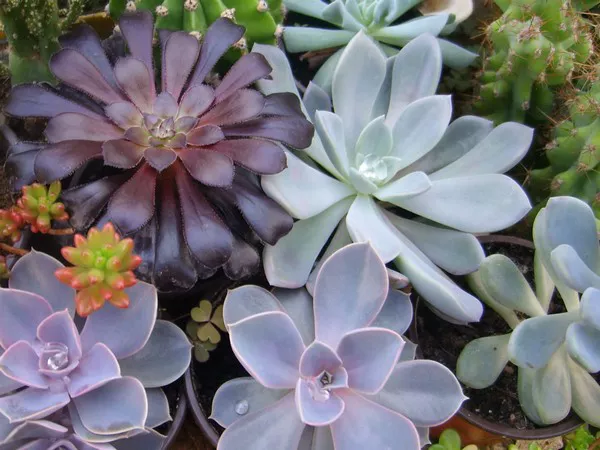Succulents have gained immense popularity as versatile and low-maintenance plants that thrive in a variety of environments. One exciting aspect of succulent gardening is the opportunity to create stunning arrangements by planting different succulent varieties together. In this comprehensive guide, we will delve into the art of combining succulents, considering factors such as growth habits, color palettes, and care requirements to ensure successful and aesthetically pleasing arrangements.
Understanding Succulent Compatibility
1. Similar Water and Sun Needs: Succulents come from diverse habitats, and pairing those with similar water and sunlight requirements is crucial. Grouping together succulents that prefer full sun with others that enjoy partial shade can lead to imbalanced growth and unsightly arrangements.
2. Consider Growth Rates: Combining succulents with similar growth rates prevents one species from overshadowing or crowding out others. Slow-growing succulents might struggle when planted alongside aggressive growers.
3. Contrasting Textures: Mixing succulents with varying textures creates dynamic visual interest. Pairing smooth-leaved succulents with those featuring intricate patterns or spines adds depth to your arrangement.
4. Color Harmony: Deliberate color combinations enhance the beauty of your succulent arrangement. Experiment with contrasting or complementary colors to achieve striking effects.
Succulent Combinations for Different Settings
1. Outdoor Succulent Gardens: Outdoor spaces offer ample room for creativity. Pair hardy succulents like Sedum, Sempervivum, and Agave for a robust desert-themed garden. For a coastal vibe, combine blue-toned succulents such as Echeveria ‘Blue Bird’ and Senecio mandraliscae.
2. Indoor Displays: Indoors, space may be limited, but creativity knows no bounds. Create a windowsill oasis with petite Haworthia varieties alongside trailing String of Pearls (Senecio rowleyanus). In low-light areas, Zamioculcas zamiifolia (ZZ plant) can complement sculptural succulents like Euphorbia trigona.
Vertical Gardens and Containers
1. Vertical Delights: Vertical gardens are perfect for space optimization. Combine succulents with trailing tendencies, such as Sedum morganianum (Burro’s Tail), with upright growers like Aloe vera for a visually captivating living wall.
2. Thrilling Thriller-Filler-Spiller Arrangements: Create dynamic container displays by following the “thriller-filler-spiller” formula. A tall “thriller” succulent like Kalanchoe luciae (Paddle Plant) can be surrounded by “filler” succulents like Echeveria and “spiller” plants like Sedum rupestre ‘Angelina’ that cascade over the edges.
Succulent Partnerships for Specific Themes
1. Cacti and Succulent Harmony: Pairing cacti with other succulents can lead to visually appealing and water-efficient arrangements. A barrel cactus (Ferocactus) can be paired with Golden Barrel Cactus (Echinocactus grusonii) for a desert vista effect.
2. Elegant Monochromatic Displays: Embrace simplicity with monochromatic arrangements. Combine various succulent species in shades of green, or explore the elegance of soft pastel arrangements featuring shades of pink, lavender, and pale blue.
Guidelines for Planting Succulents Together
1. Choose the Right Container: The container’s size and material influence succulent growth. Ensure adequate drainage holes to prevent waterlogged soil and consider using shallow containers that match the root systems’ growth patterns.
2. Use Well-Draining Soil: Succulents thrive in well-draining soil to prevent root rot. A mix of potting soil and coarse sand or perlite provides the necessary drainage.
3. Mindful Placement: Consider the eventual size of each succulent when placing them in the arrangement. Allow enough space for growth to prevent overcrowding.
Caring for Your Succulent Ensemble
1. Watering Routine: Despite their water-storing capabilities, succulents need hydration. Water thoroughly but infrequently, allowing the soil to dry out between waterings.
2. Sunlight Requirements: Pay attention to the lighting preferences of the succulents in your arrangement. Place sun-loving succulents in direct light and shade-loving ones in areas with filtered or indirect sunlight.
3. Regular Maintenance: Remove spent or damaged leaves to maintain the arrangement’s aesthetic appeal. Prune leggy growth to encourage compactness.
Conclusion
Creating harmonious and visually captivating succulent arrangements is an art that combines knowledge, creativity, and a touch of horticultural finesse. By considering factors such as water and sunlight needs, growth habits, textures, and color palettes, you can design stunning succulent displays that thrive and delight in any setting. Whether you’re crafting an outdoor desert garden, an indoor windowsill display, or a vertical living wall, the possibilities are as diverse as the succulent species themselves. With careful planning and proper care, your succulent partnerships will flourish, bringing beauty and charm to your living spaces.


